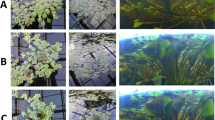Abstract
Dryas octopetala has heliotropic flowers, whose petals reflect the light on the pistils, thus warming them up. The effects of this reflection on seed formation and development were studied by measuring the pistil temperature of intact flowers, of flowers with petals removed, of shaded flowers, and of flowers constrained in such a way as always to be directed towards the zenith. In August, the seeds of these flowers were collected, counted and weighed. The temperature differences between the differently treated flowers were greates about noon, the flowers ranking as follows in ascending order of temperature: shaded flowers, flowers without petals, constrained flowers and intact flowers. The mean temperature differences between the gynoecia and the air, in degrees Celsius, were: 1.1, 1.8, 2.5 and 3.2, respectively. The same ranking was obtained for the different treatments, when arranged in order of ascending weight per seed, except that the positions of the shaded flowers and the flowers without petals were interchanged. The mean values of the weight per seed in milligrams were: 0.42, 0.48, 0.53 and 0.61 for the groups flowers without petals, shaded flowers, constrained flowers and intact flowers, respectively.
Similar content being viewed by others
References
Andersson E (1965) Cone and Seed Studied in Norway Spruce. Studia Forestalia Suecica Nr. 23
Bailey NT (1959) Statistical Methods in Biology, London, The English Universities Press Ltd
Forseth I, Ehleringer JR (1980) Solar tracking response to drought in a desert annual. Oecol 44:159–163
Hocking B (1968) Insect-flower associations in the high artic with special reference to nectar. Oikos 19, 359–374
Kardell L (1973) Tallfröstudier i Norrland, Lund, Berlinska boktryckeriet
Kevan PG (1975) Sun-tracking solar furnaces in high arctic flowers: significance for pollination and insects. Science 189, 723–726
Lang ARG and Begg JE (1979) Movements of Helianthus Annuus leaves and heads. Journal of Applied Ecology 16, 299–305
Mayo JM, Hartgerink AP, Despain DG, Thompson RG, van Zinderen Bakker Jr EM, Nelson SD (1977) Gas exchange studies of Carex and Dryas, Truelove Lowland. In: Bliss LC (ed) Truelove Lowland, Devon Island, Canada: A high arctic ecosystem. The Univ of Alberta Press, pp. 265–280
Mooney HA, Ehleringer JR (1978) The carbon gain benefits of solar tracking in a desert annual. Plant, Cell and Environment 1:307–311
Wainwright CM (1977) Sun-tracking and related movements in a desert lupine (Lupinus arizonicus). Amer J Bot 64:1032–1041
Author information
Authors and Affiliations
Rights and permissions
About this article
Cite this article
Kjellberg, B., Karlsson, S. & Kerstensson, I. Effects of heliotropic movements of flowers of Dryas octopetala L. on gynoecium temperature and seed development. Oecologia 54, 10–13 (1982). https://doi.org/10.1007/BF00541101
Received:
Issue Date:
DOI: https://doi.org/10.1007/BF00541101




